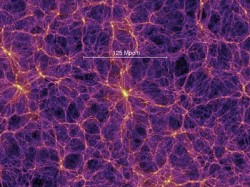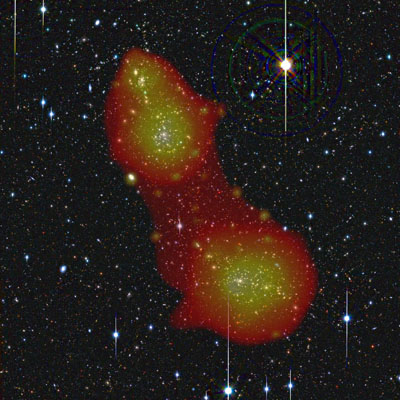We’re getting the numbers down pretty well now about how much we don’t know about the universe: Only about 5% of our universe consists of normal matter, made of atoms. The rest of our universe is composed of elusive matter that we don’t understand: dark matter (23%) and dark energy (72%). And of that 5% of normal matter, well, we don’t know what half of that is, either. All the stars, galaxies and gas observable in the universe account for less than a half of all the matter that should be around.
About 10 years ago, scientists predicted that the missing half of ‘ordinary’ or normal matter exists in the form of low-density gas, filling vast spaces between galaxies. The European Space Agency announced today that the orbiting X-ray observatory XMM-Newton has uncovered this low density, but high temperature gas.
The universe has been described as a cosmic web. The dense part of the web is made of clusters of galaxies, which are the largest objects in the universe. Astronomers suspected that low-density gas filled in the filaments of the web. But the low density of the gas has made it difficult to detect. With the XMM-Newton’s high sensitivity, astronomers have discovered the hottest parts of this gas.
Astronomers using XMM-Newton were observing a pair of galaxy clusters, Abell 222 and Abell 223, located 230 million light-years from Earth, when the images and spectra of the system revealed a bridge of hot gas connecting the clusters.

“The hot gas that we see in this bridge or filament is probably the hottest and densest part of the diffuse gas in the cosmic web, believed to constitute about half the baryonic matter in the universe,” says Norbert Werner from SRON Netherlands Institute for Space Research, leader of the team reporting the discovery.
The discovery of this hot gas will help better understand the evolution of the cosmic web.
“This is only the beginning,” said Werner. “To understand the distribution of the matter within the cosmic web, we have to see more systems like this one. And ultimately launch a dedicated space observatory to observe the cosmic web with a much higher sensitivity than possible with current missions. Our result allows to set up reliable requirements for those new missions.”
Original News Source: ESA Press Release


Hmm . . . could it be that dark energy (72%)evolves into dark matter (23%) which might evolve into visible matter. Maybe the big bang singularity theory is nothing more than dark energy morphing into visible matter over some time-scale other than an explosive nano-second event. Does this scenario clash. with known expansion or any physical laws? This might explain the existance of blue-shifted galaxies and the chaotic directions the galaxies appear to move. And just maybe the universe is infinate and we might be inside a sphere defined by our ability to see no more than, say, .99% red-shift distance from earth. We may be the tiniest of tiny specks in an unimaginably huge void. Occum’s razor comes to mind.
Blimey. That means close to 98-99% of matter in the Universe we can’t find, never mind see!
That’s depressing
At the rate they are discovering dark matter, we should end up 99.999999% of the universe is made of dark matter. This is exactly what I have calculated and show to be the case. But there is a little trick
to create dark matter. For a hint see my web site at
cosmicdarkmatter.com